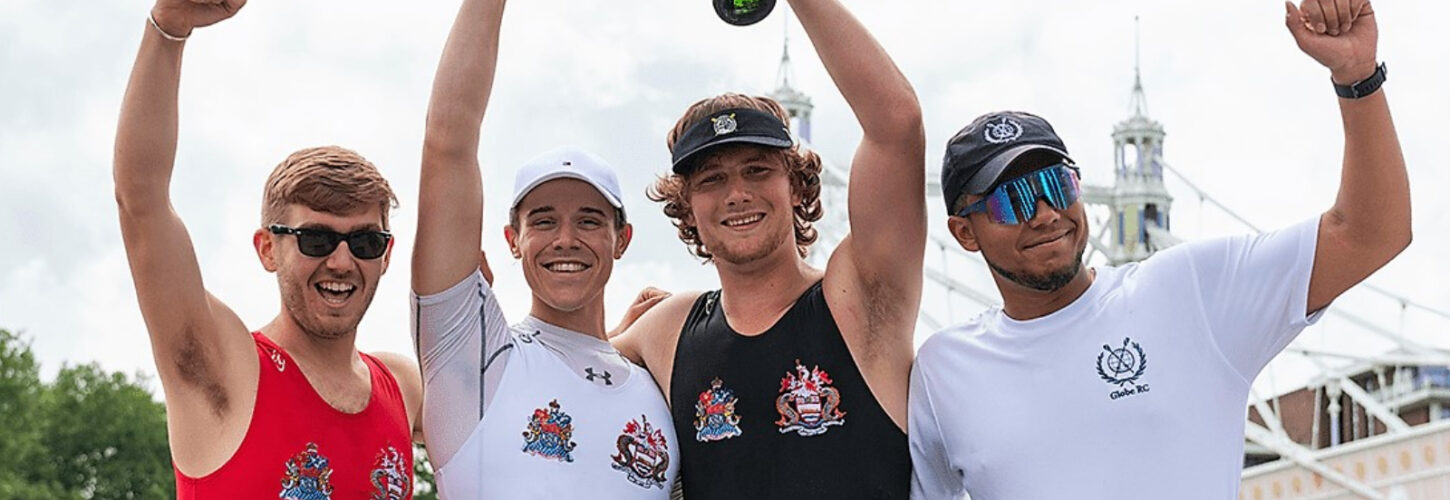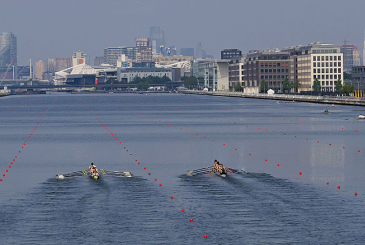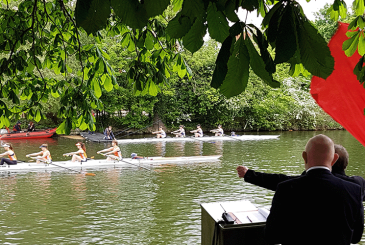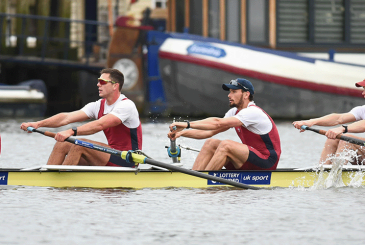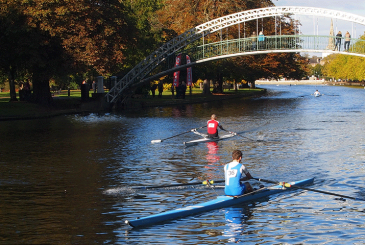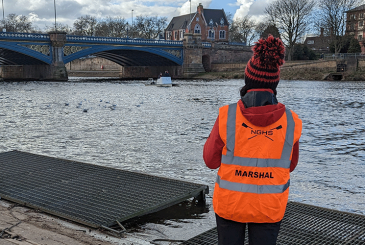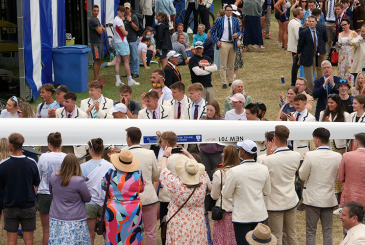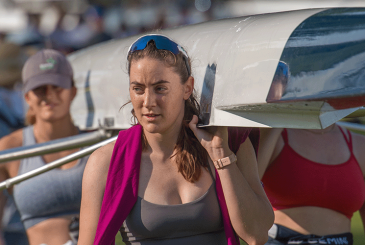Four young rowers will vye for the 2021 Doggett’s Coat and Badge race on the River Thames in London on Wednesday 8 September. Chris Dodd explores the history of this famous contest
Doggett’s Coat and Badge will be sculled on 8 September for the second time this year. The 2020 race took place in June, delayed for 12 months by the pandemic, with James Berry from Whitstable (pictured second from the left above) winning the contest.
Thus, with three 2020 runners entered for their second attempt at the coveted prize, we have a good form guide for the 2021 race. Max Carter-Miller pencilled his name on the 306th Doggett’s wager by giving the 2020 winner James a run for his money. George Gilbert and Coran Cherry will also make a second attempt to win this severest test of watermanship, while Lucas Brittan is having his first go.
The sculling race is open to up to six watermen, under 26 years of age, who have finished their apprenticeship in watermanship. Unsuccessful competitors may have up to three consecutive attempts.
Founded by Thomas Doggett, an Irish actor and theatre manager, the race began from London Bridge to Cadogan Pier, Chelsea in 1715. It quickly became the most sought after badge of competency at the oars, not least because it was open only open to apprentice watermen in their last year of indenture.
In the 18th and 19th-centuries the silver badge and orange (now scarlet) coat was a sign of prowess for touting custom at the hundreds of steps along the banks of the Thames through Southwark, Westminster and the City. But since the 1970s, Doggett’s serves as a springboard to the national team. Bobby Prentice, the current umpire and Bargemaster to the Fishmongers’ Company that looks after the founder’s will to keep the race going in perpetuity, became a GB international after winning the coat and badge, as did a string of other winners, notably Ken Dwan and Simon McCarthy. Prentice set the race record of 22 minutes and 23 seconds in 1973.
Undisputedly, Doggett’s is a tough call. The course curves for 4 miles 5 furlongs (7.44 km), originally against an ebb tide but nowadays on the flood. The Thames takes no prisoners here. More often than not the water is lumpy, the wind is swirly and the tideway is busy. The course presents a succession of obstacles – piers, moving and moored barges, ferries and about fifteen bridges, every one of which crosses the river at an angle. There’s no preferred way. Scullers must decide whether to cut corners or suss out the tide, pick centre or side arches to shoot, chase an opponent or row their own race.
And it was ever thus. Today’s scullers will have attended training camps organised by the Watermen’s Company, but a century ago, Doggett’s contestants made their own training. The unpublished memoirs of George Pocock relate a good example. George’s elder brother Dick won the badge in 1910, though the watermen of the tideway would not have given him a prayer before the race because he came from the upper, non-tidal river.
Dick and George’s father Aaron built and maintained Eton College’s vast fleet of racing boats. The boys left the National School aged 14 and were apprenticed to their father, teaching Eton boys and building and delivering boats to clients by rowing them for mile after mile along the Thames.
George was the training partner for 6ft 5in Dick. They took two outings a day on their home stretch of two and a half miles. Then, two weeks before Doggett’s, they sculled 35 miles from Eton down to London, storing their boats in an old shack under London Bridge. They had no changing facilities or shower, and commuted from Eton daily for two weeks of well-handled outings on rough water which, George says, ‘is proof that watermanship is learned on smooth water’. In the race, Dick took the lead from the first stroke and was never headed.
Aaron Pocock served as Bargemaster to the Fishmongers and umpired the race for ten years. His most nerve-wracking task was achieving a clean start on a fast-running tide amongst heavy river traffic. The scullers were attached to stake boats, but once they detached, could not be called back. Starting by megaphone was impossible, for the competitors set off as soon as the instrument was raised to the starter’s lips. Similarly, a shot from a starting pistol was anticipated as soon as the umpire raised his arm. Aaron’s solution was to hide behind the wheelhouse of his launch until the captain told him that the boats appeared ready. Then he would leap out and wave his flag.
Among the Eton boys for whom George built singles and taught how to scull them were Crown Prince Prajadhipok of what was then Siam; Lord Grosvenor, son of the Duke of Westminster, the world’s richest man; heirs to the Blue Funnel and the Cunard shipping lines; a future Prime Minister, Anthony Eden; and the biochemist J B S Haldane.
George never challenged for Doggett’s because he and his brother were looking for work in America during his final year of eligibility. They began by repairing boats at Vancouver Rowing Club in return for accommodation. George was then recruited by Hiram Conibear to build a fleet for the University of Washington in Seattle which begat the prestigious Pocock boat building business. Brother Dick moved to look after boats at Yale.
On 8 September Bobby Prentice will start the 306th Doggett’s wager without the benefit of stake boats to help him judge if the boats are straight and ready. The stations are numbered 1-6 from North to South bank and drawn as follows: 1 Coran Cherry (red); 2 Lucas Brittan (white); 3 Max Carter-Miller (light blue); 4 George Gilbert (black).
May the best waterman win!
Photo: Ben Fitzpatrick


